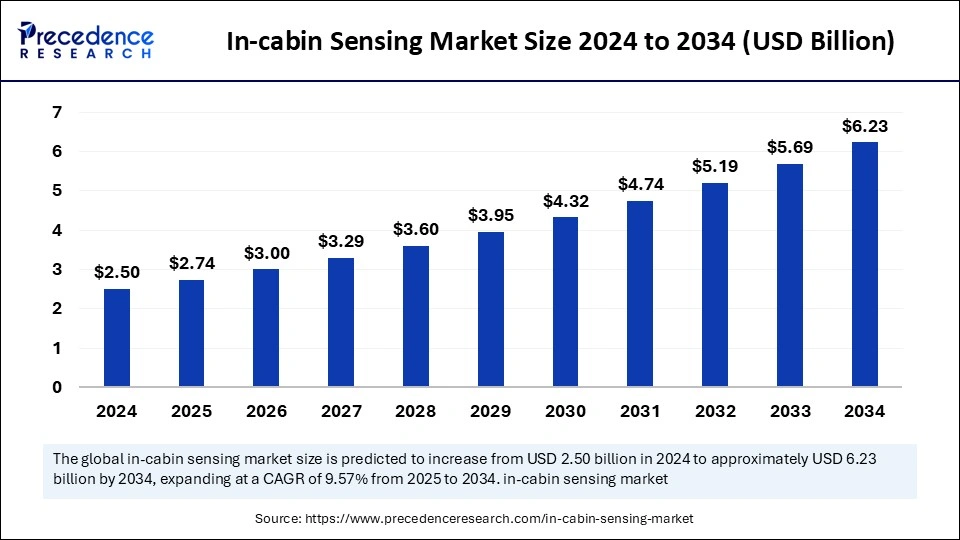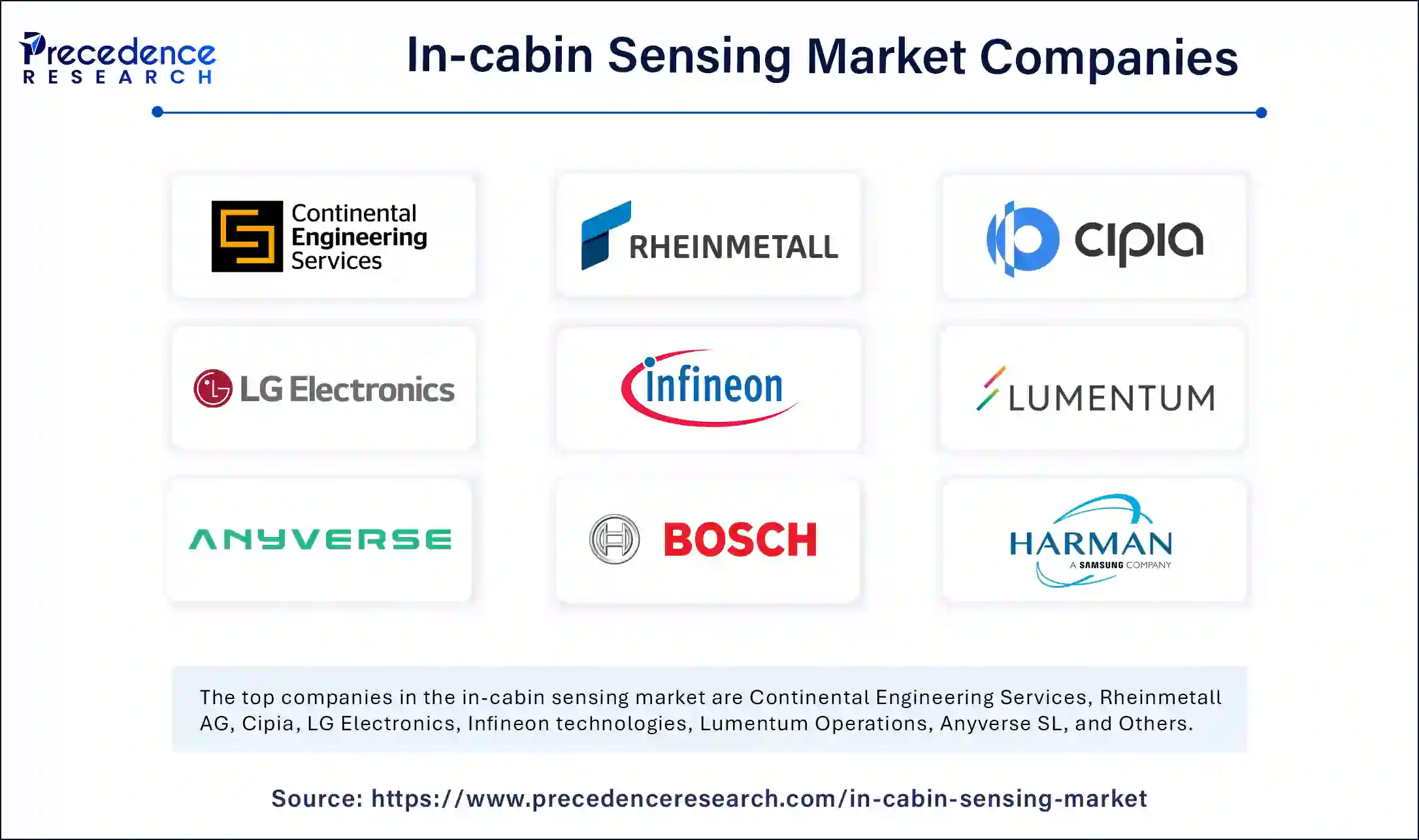The global in-cabin sensing market size was valued at USD 2.50 billion in 2024 and is expected to cross around USD 6.23 billion by 2034, growing at a CAGR of 9.57% from 2025 to 2034.

In-cabin Sensing Market Key Points
-
North America dominated the market share in 2024.
-
The Asia-Pacific region is projected to experience rapid growth during the forecast period.
-
The capacitive steering sensors segment led the market by sensor type in 2024.
-
The torque steering sensors segment is expected to see significant growth in the coming years.
-
The driver monitoring systems segment accounted for the largest market share in 2024.
-
The cabin monitoring systems segment is anticipated to grow at a notable rate in the future.
-
The automotive segment emerged as the leading end-user in 2024.
Role of AI in the In-Cabin Sensing Market
Artificial Intelligence (AI) is transforming the in-cabin sensing market by enhancing vehicle safety, personalization, and user experience. AI-driven technologies are enabling real-time monitoring of driver behavior, passenger activities, and environmental conditions inside the vehicle. By leveraging advanced computer vision, machine learning, and sensor fusion, AI is making in-cabin sensing systems more intelligent, responsive, and efficient.
One of the primary roles of AI in in-cabin sensing is driver monitoring. AI-powered driver monitoring systems (DMS) use facial recognition and eye-tracking technology to detect signs of drowsiness, distraction, or intoxication. These systems can alert the driver or take corrective actions, such as slowing down the vehicle or activating autonomous driving modes, thereby reducing accident risks. Additionally, AI-based emotion recognition can assess driver stress levels and adjust in-car settings like lighting, music, or climate control to improve comfort and safety.
AI is also enhancing passenger monitoring systems (PMS) by recognizing seating positions, detecting seatbelt usage, and identifying the number of occupants in the vehicle. This data helps optimize airbag deployment, child safety seat detection, and emergency response systems. Moreover, AI-driven cabin monitoring systems can analyze gestures and voice commands, enabling touchless interactions with infotainment systems and smart assistants.
Another key role of AI in in-cabin sensing is improving personalization and comfort. AI algorithms analyze passenger preferences, such as preferred seat positions, climate settings, and entertainment choices, to create a customized in-car experience. In ride-sharing and autonomous vehicle applications, AI can recognize different passengers and automatically adjust settings based on their profiles.
AI also contributes to hygiene and health monitoring in modern vehicles. In-cabin sensors powered by AI can detect temperature, air quality, and the presence of harmful gases, ensuring a safer and healthier cabin environment. Some AI-enabled systems even integrate biometric monitoring to track vital signs, such as heart rate and respiration, helping identify medical emergencies.
As AI technology continues to evolve, its role in the in-cabin sensing market will expand further, making vehicles safer, smarter, and more user-friendly. With advancements in deep learning, real-time analytics, and edge computing, AI-driven in-cabin sensing systems will play a crucial role in the future of connected and autonomous mobility
In-Cabin Sensing: Overview, Technologies, and Applications
Overview of In-Cabin Sensing
In-cabin sensing is an advanced vehicle technology designed to monitor and analyze the interior environment of a car, including driver behavior, passenger activity, and overall cabin conditions. By utilizing a combination of cameras, sensors, and artificial intelligence (AI), in-cabin sensing systems enhance safety, comfort, and user experience. Automakers and tech companies are increasingly integrating these systems into modern vehicles to comply with safety regulations and improve in-car intelligence.
Get a Free Sample Copy of the Report@ https://www.precedenceresearch.com/sample/5788
Key Technologies in In-Cabin Sensing
-
AI and Machine Learning – AI-powered algorithms process data from sensors and cameras to detect driver fatigue, distractions, or emotional states.
-
Computer Vision – Advanced image recognition and facial tracking technologies analyze driver and passenger behavior in real-time.
-
Infrared and Thermal Sensors – Used for night-time and low-light monitoring, helping detect occupants’ presence and body temperature.
-
LiDAR and Radar Sensors – Provide depth perception and object detection to improve situational awareness inside the cabin.
-
Voice and Gesture Recognition – Enables touchless interaction with the vehicle’s infotainment and control systems.
-
Biometric Sensors – Detect heart rate, respiration, and stress levels, helping monitor driver health and well-being.
Applications of In-Cabin Sensing
-
Driver Monitoring Systems (DMS)
-
Tracks eye movement, head position, and facial expressions to detect drowsiness, distraction, or intoxication.
-
Alerts the driver or activates autonomous driving assistance if necessary.
-
Helps comply with road safety regulations, such as the European Union’s General Safety Regulation (GSR).
-
-
Passenger Monitoring Systems (PMS)
-
Recognizes passenger occupancy, seatbelt usage, and child seat placement to optimize airbag deployment.
-
Enhances security in ride-sharing and autonomous vehicles by detecting unauthorized passengers.
-
Personalizes in-car experiences by adjusting climate control, seating, and entertainment preferences.
-
-
Cabin Monitoring & Safety Features
-
Detects hazardous situations like leaving a child or pet inside a locked car.
-
Monitors air quality, CO2 levels, and temperature to maintain a healthy cabin environment.
-
Integrates with emergency response systems to provide real-time alerts during medical emergencies.
-
-
Infotainment and Human-Machine Interaction (HMI)
-
Enables voice commands, hand gestures, and facial recognition for seamless control of infotainment systems.
-
Supports personalization by recognizing individual passengers and adjusting settings accordingly.
-
Future Trends in In-Cabin Sensing
-
Integration with Autonomous Vehicles – In-cabin sensing will play a crucial role in ensuring passenger safety and engagement in self-driving cars.
-
AI-Driven Predictive Analytics – Advanced algorithms will analyze historical data to predict and prevent risky driving behaviors.
-
Health and Wellness Monitoring – Future vehicles may feature AI-powered biometric tracking for early detection of health conditions like heart attacks or seizures.
-
Enhanced Privacy and Data Security – As in-cabin sensing relies on personal data, improved encryption and cybersecurity measures will become essential.
Market Scope
| Report Coverage | Details |
| Market Size by 2034 | USD 6.23 Billion |
| Market Size in 2025 | USD 2.74 Billion |
| Market Size in 2024 | USD 2.50 Billion |
| Market Growth Rate from 2025 to 2034 | CAGR of 9.57% |
| Dominated Region | North America |
| Fastest Growing Market | Asia Pacific |
| Base Year | 2024 |
| Forecast Period | 2025 to 2034 |
| Segments Covered | Sensor Type, Monitoring System, End-user, and Regions |
| Regions Covered | North America, Europe, Asia-Pacific, Latin America and Middle East & Africa |
The in-cabin sensing market is experiencing significant growth due to the increasing demand for advanced vehicle safety features and enhanced user experiences. These systems leverage a combination of AI, sensors, and cameras to monitor both the driver and passengers, ensuring safer, more efficient, and personalized driving experiences. As autonomous vehicles continue to evolve, in-cabin sensing technologies are becoming a critical component in ensuring passenger safety, comfort, and well-being. This market is expected to expand as consumers and regulators alike prioritize safety and convenience.
Drivers
Key drivers of the in-cabin sensing market include the growing need for enhanced driver and passenger safety. Systems such as driver monitoring and passenger recognition technologies help reduce accidents caused by distractions, fatigue, or medical emergencies. Another driver is the increasing adoption of autonomous vehicles, which requires sophisticated in-cabin monitoring systems to ensure the vehicle operates efficiently and safely without a human driver. Additionally, rising consumer expectations for personalized in-vehicle experiences are pushing the demand for advanced cabin sensing technologies.
Opportunities
There are several opportunities in the in-cabin sensing market, especially with advancements in AI and machine learning technologies. These technologies allow for real-time analysis of driver behavior and passenger preferences, which can enhance both safety and comfort. Moreover, the integration of biometric sensors to monitor health conditions such as heart rate or stress levels opens up new opportunities for preventive health care. Another opportunity lies in the development of ride-sharing and autonomous vehicle services, where advanced in-cabin sensing can be used for improved security and customer service.
Challenges
The main challenges in the in-cabin sensing market include privacy concerns, data security issues, and the high cost of advanced sensing technologies. As these systems collect personal data, consumers are increasingly concerned about how their information is stored and used. Furthermore, the complexity and cost of integrating such sophisticated systems into vehicles can pose barriers to widespread adoption. Additionally, there is a lack of standardization in terms of regulatory frameworks for in-cabin sensing technologies, which can slow down market growth.
Regional Insights
North America holds a dominant share of the in-cabin sensing market, primarily driven by the high adoption of advanced automotive technologies and the presence of major industry players. Europe is also witnessing substantial growth, with an emphasis on vehicle safety regulations and the development of autonomous vehicle technologies. The Asia-Pacific region is expected to see rapid growth due to the increasing demand for connected and autonomous vehicles, especially in countries like China, Japan, and South Korea, where smart mobility solutions are gaining traction.
In-cabin Sensing Market Companies

- Continental Engineering Services
- Rheinmetall AG
- Cipia
- LG Electronics (LG)
- Infineon technologies
- Lumentum Operations
- Anyverse SL
- Robert Bosch GmbH
- HARMAN International
Recent Developments
- In January 2025, MulticoreWare, Inc. and Cipia teamed up to showcase a cutting-edge demonstration of in-cabin monitoring sensor fusion at CES 2025. This demonstration fuses 60GHz radar and IR camera technologies, combining their strengths to present precise tracking of driver and occupant vital signs, even in complex conditions. By collaborating with Cipia, a leader in computer vision and AI in-cabin monitoring solutions, MulticoreWare aims to push the boundaries of innovation and deliver advanced safety solutions for the automotive industry.
- In June 2023, Cipia announced a new solution from its continuing collaboration with Ambarella, Inc., an edge AI semiconductor company. This latest solution offers automotive manufacturers higher flexibility regarding the location of in-cabin sensing systems, including the rear-view mirror, as well as the ability to use a single camera.
- In May 2023, Smart Eye announced a collaboration with Texas Instruments to provide automakers with an innovative interior sensing solution that improves driver safety and enables in-cabin experiences that enhance comfort, wellness, and entertainment. Fully compliant with the new General Safety Regulations (GSR) and European New Car Assessment Program (Euro NCAP), the solution enables higher performance and more cost-effective implementations in vehicles.
Segments Covered in the Report
By Sensor Type
- Capacitive Steering Sensors
- Torque Steering Sensors
- Printed Sensors
By Monitoring System
- Driver Monitoring Systems
- Cabin Monitoring Systems
- Thermal Monitoring Systems
By End-user
- Automotive
- Electrical & Electronics
- Aerospace & Defence
By Region
- North America
- Asia Pacific
- Europe
- Latin America
- Middle East and Africa
Also Read: Automotive Overhead Console Market
Get a Free Sample Copy of the Report@ https://www.precedenceresearch.com/
